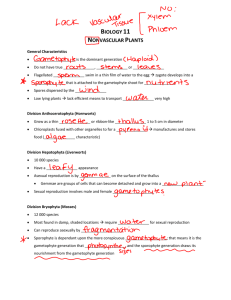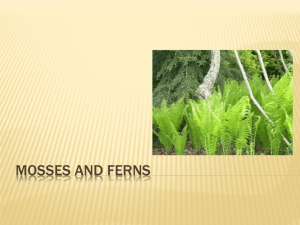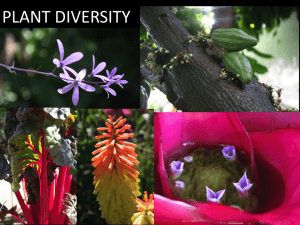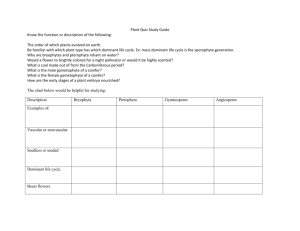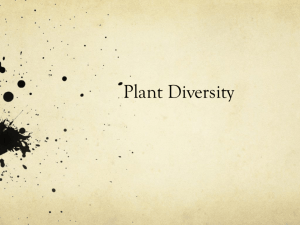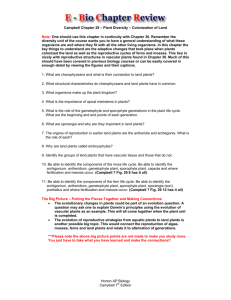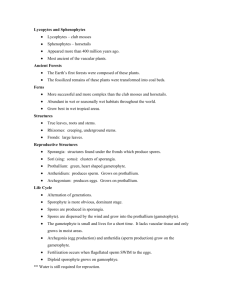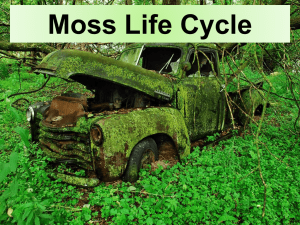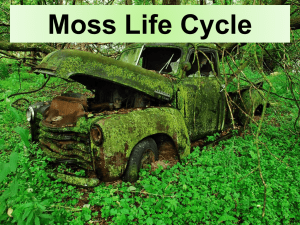Click on image to content
advertisement
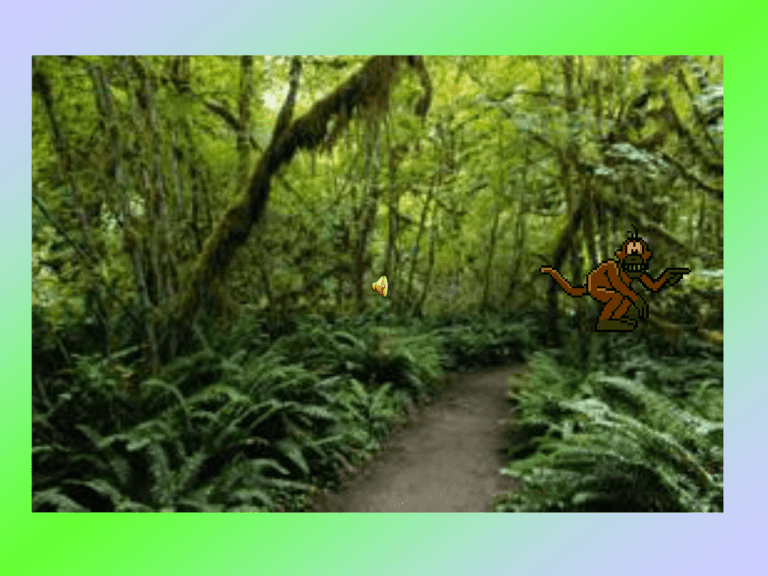
Topic: Plants Objectives: 1. Describe the current classification of land plants 2. Outline the life cycle of moss and ferns 3. Contrast gymnosperms and angiosperms/monocots and dicots 4. Discuss the function of several types of plant tissue Text Reference Chapters 22, 23, 24 Classification Kingdom Plantae multicellular, eukaryotic, non-motile, contain chlorophyll a + b, cell walls of cellulose, reproduce sexually Phylum Bryophyta Lack vascular tissue Gametophyte dominant. Live in moist areas. Reproduction dependent on water. Moss, liverworts Phylum Tracheophyta Contain xylem and phloem Sporophyte dominant Most common plants. Subphylum Pteropsida Ferns. Reproduction dependent on water. Subphylum Spermopsida Seed plants. (Gymnosperms – naked seeds.) Class Coniferae – seeds in cones. Needlelike leaves. Class Angiospermae Flowering plants. Seeds develop in ovaries. Subclass – Monocotyledonae Embryo with a single cotyledon leaves parallel flower parts in threes Grasses, palm Subclass – Dicotylendonae Embryo with two cotyledons Netted veination Flower parts in 4 or 5 Life cycles of moss and ferns Figure 22–11 The Life Cycle of a Moss Haploid (N) Diploid (2N) MEIOSIS Spores (N) Protonema (young gametophyte) (N) Male gametophyte Female gametophyte Mature sporophyte (2N) Capsule (sporangium) Gametophyte (N) Antheridia Young sporophyte (2N) Sperm (N) Archegonia Zygote (2N) Gametophyte (N) Sperm (N) Egg (N) FERTILIZATION Figure 22–17 The Life Cycle of a Fern MEIOSIS Sporangium (2N) Haploid gametophyte (N) Diploid sporophyte (2N) Frond Spores (N) Mature sporophyte (2N) Developing sporophyte (2N) Antheridium Young gametophyte (N) Mature gametophyte (N) Sperm Gametophyte (N) Egg Sporophyte embryo (2N) Archegonium FERTILIZATION The Spermopsida A. Overview. Designed for life on land B. Adaptations Roots absorb nutrients and water, hold plant upright, Stems Hold leaves up to sunlight Transport water and nutrients Leaves Perform photosynthesis Vascular tissue Transport materials Xylem- transports water and nutrients toward the leaves. Phloem- transports the products of photosynthesis around the plant Reproduction adapted for life on “dry” land Pollen – contains sperm Seeds- contains embryo Fig. 22-5 p. 470 Gymnosperms “Naked” seeds Example Conifers Angiosperms Flowering plants Egg is protected in an ovary. Ripe ovary is a fruit 1. Monocots- Fig 2212 p. 475 2. Dicots- Fig 22-12 p. 475 A square watermelon. Plant Tissue Meristematic tissue Produces new cells by mitosis. Undifferentiated. Meristematic tissue 1. Apical meristem – at the tip of a growing stem or root 2. Cambium – allows stems and roots to grow thicker Vascular cambium Cork cambium Pericycle Epidermal tissue Provides protection Cork(bark) – keeps water out Epidermis – lets water in Parenchyma Thin walled cells Store things Some contain chloroplasts Some store starch Sclerenchyma Thick walled cells Support the plant Vascular tissue Internal transport Xylem Made of tracheids Long narrow cells with openings at each end Fig 23-6 p. 493 Vessel elements Much larger than tracheids Transport water. Phloem Transports plant products Fig. 23-7 p. 493 Sieve tube elements- allow the passage of materials Companion cells - control activity of the sieve tube I know what you are thinking. You are thinking……… Mr. Barnes……………. May we please, please, please, please, please, please, please, please, please, please, please, please, please, please, please, please, please, please Have a ……………….. Fun Review Activity!!!!!!!!!! Diagram the life cycle of • Moss • Fern • Flowering plant Label haploid (gametophyte) and diploid (sporophyte) phases Have a great day!
